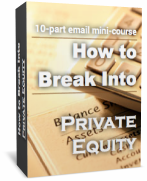How do private equity firms really make money? Management fees may shed light on why PE investors have such high salaries, no matter whether the PE firm has successfully exited an investment. But how is it that some private equity titans, like Henry Kravis of KKR and Stephen Schwarzman of Blackstone, can make a windfall half-billion dollars in a single year?
To understand how private equity firms really make money, you have to understand how the returns distribution waterfall works. The typical split in profits between LPs and GP is 80 / 20. That means, the LP gets distributed 80% of the profits on an exit (after returning their initial capital) and the GP keeps 20% of the profits. This 20% is known as “carried interest,” or “carry.” The carry is then split up between the PE firm’s investment professionals, with most of the distributions going to the partners, while the LPs then divvy up the 80% they received based on their proportional contribution to the fund.
Now typically, a GP will only commit 1-5% of the capital of the fund; my firm contributed about 10%, which was extraordinarily high by industry standards. So think about it: the GP contributes 1-5% of the fund (or perhaps 10% at the extreme), but they get to keep 20% of the profits. That’s how private equity firms are able to reap such enormous returns.
Let’s walk through a quick example. Say a PE firm called Awesome Capital Partners raises a $1B fund, with $950M coming from LPs and $50M coming from the GP (that’s 5% contribution from the GP). The GP then invests all the capital in acquiring companies. A few years down the road, they exit all their portfolio companies for $2B total. The LPs get $1B back first — that’s returning their capital. That leaves $1B left, and it’s divided up 80 / 20 between LPs and GP. So the LPs get $800M and the GP gets $200M. So the GP invested $50M at the start, but gets back $200M in profits — already a 4x return, gangbusters by any standard you could apply in PE.
But there’s more. The GP doesn’t divide that pot evenly. The senior partners collect the vast majority of the profits, so if the firm only has 10 investment professionals, 4 of which are partners, and only 2 of which are senior partners, you could see how $150M in profits to the GP can quickly become a big payday for the senior partners of the firm, especially if half or more go to 2 senior partners alone. That’s just an example of a firm that raised $1B. But what about when a firm, like TPG, has more than $50B under management? They certainly have a bigger staff of investment professionals, but it’s not anywhere near 50x bigger than the $1B fund.
You see where this is going. The more AuM there is relative to the number of partners at the firm, the bigger the payday on an exit year — assuming the investments didn’t go bankrupt!
Be sure to check out our PDF guide “How to Nail Your Private Equity Interview (whether you have finance training or not)” for in-depth tips and strategies on how to successfully interview for jobs at top private equity firms!
Also be sure to check out our step-by-step Private Equity LBO Modeling Training Videos for walk-through tutorials on how to build an LBO model, navigate Excel with ruthless efficiency, and rapidly create an LBO PowerPoint deck to present to your PE interviewers.
